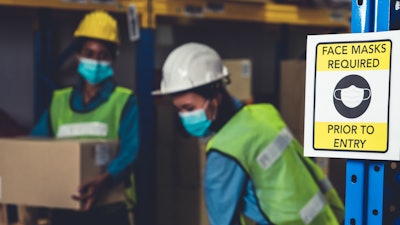
As manufacturers across the globe look to ensure worker safety and production continuity, here are some key facts and strategies to consider. Some relate to COVID protocols, while others are simply best practices for enterprise-wide worker safety. According to health and safety consultant Arinite, the average cost of health and safety fines is 244 percent higher than the cost of compliance. So, the big questions is: what are you doing to stay on top of your compliance?
It can be tricky to judge just exactly how compliant you are as a company, so some of the actions to watch out for in avoiding fines can include:
- Cost-cutting at the expense of safety.
- Deliberate concealment of illegal activity.
- Breaching a court order.
- Obstruction of justice.
- A poor health and safety record – it’s worse if there were a previous conviction.
This means staying on top of:
- Ensuring effective health and safety procedures in place.
- Verifying that steps have been taken voluntarily to remedy a problem.
- Maintaining a good health and safety record.
The manufacturing and construction industries typically get the largest volume of fines simply due to the nature of the work, which involves working from height, working with gas, and other dangerous activities. This is why it is extremely important to constantly review your processes and keep them up to date. While compliance costs may not be rising steeply, the penalty costs certainly are.
As working from home becomes the new normal due to COVID-19, many businesses have had to embrace ‘remote work’, leading to the hiring process also becoming remote.
Many believe that on-site onboarding is essential as it enables new employees to be welcomed in person, where they can meet colleagues, achieve answers to important questions easier, and get a sense of the workplace environment. However, the recent pandemic has shifted the workplace culture towards remote working and remote on-boarding, leading organisations to incorporate strategies that ensure they are equipped to deal with remote hiring, training and development.
This highlights the importance of creating a quality remote onboarding process where training and development opportunities are made clear to the new hire. Remote onboarding doesn’t need to imitate on-site onboarding as thoughtful experiences can be built that keep new employees engaged whilst the key benefits of remote onboarding can also be taken advantage of, which includes:
- Flexibility. New hires can complete training in their own time and speed. The platform should ensure training is delivered to long distanced employees and that they will receive a good induction regardless of their circumstances, which is critical when trying to avoid an early exit.
- Eliminating time consuming manual processes. Much of the hiring process is consumed with paperwork. By digitalising the training process, this reduces the amount of time spent on manual processes. Time can then be spent more efficiently on other areas of the onboarding process.
- Continued learning & engagement. Onboarding should be viewed as an ongoing process. The platform ensures employees are developing their skills from their start date until they leave an organization. Through continuous learning staff can complete training anytime, which in turn will allow them to feel valued within your organization, therefore increasing productivity. Platforms like Obbi Solutions can increase staff engagement by acting as a performance management tool and providing ways of communication between staff members.
- Pre-boarding. When new employees can access training programs prior to their official start dates, it allows them to arrive confident and comfortable. It also gives the new employee insight into the organization’s values.
- Cost reduction. If the onboarding process is done correctly, this should reduce the amount of employee turnover, which in turn will reduce expenses. The cost of physical onboarding, i.e. the cost of materials and personnel, is therefore reduced.
Catherine Rooney is a marketing executive for Obbi Solutions. For more information on the company’s offerings in Compliance, Onboarding, Productivity and Safety, visit their website - www.obbisolutions.com






















